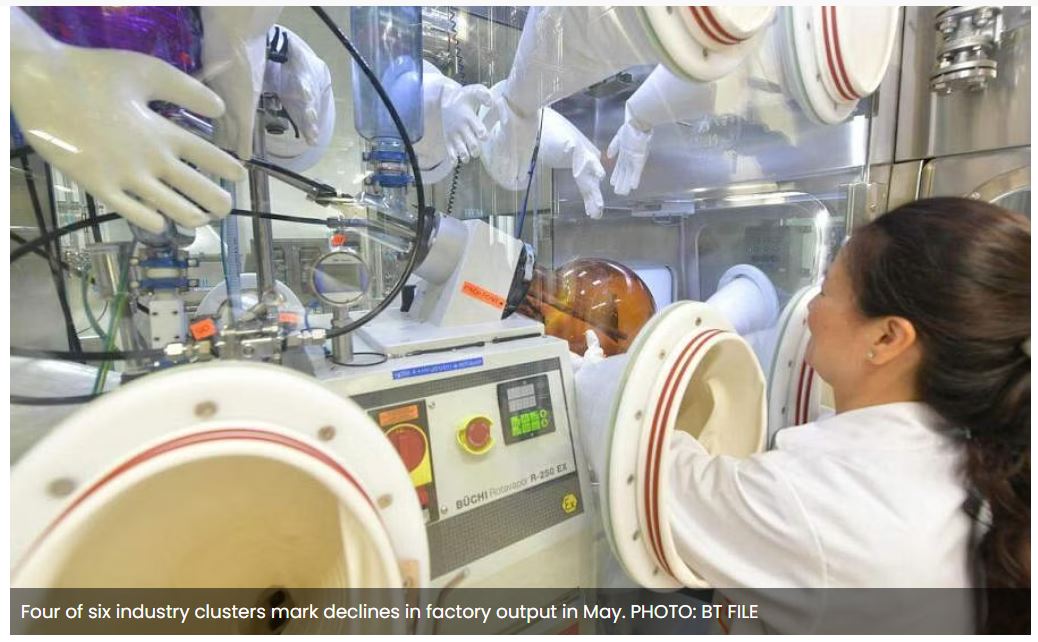Economists flag risk of technical recession for Singapore as manufacturing contracts further in May
ECONOMISTS warned of a heightened risk of a technical recession in the first half of 2023, as factory output contracted by 10.8 per cent on year in May, worse than Bloomberg’s median forecast of a 7.3 per cent drop. Electronics continued to disappoint.
Marking eight straight months of decline, the fall in Singapore’s manufacturing output last month was steeper than April’s surprise 6.5 per cent fall, Economic Development Board (EDB) data showed on Monday (Jun 26). It was also the first double-digit drop recorded since November 2019.
Excluding the typically volatile biomedical cluster, factory output shrank 13 per cent, following the 5.7 per cent year-on-year (y-o-y) fall in April.
The results were not unexpected considering other recent data, said economists.
“Singapore faces a heightened risk of a technical recession in H1 2023, following the annual contraction in externally facing indicators,” said RHB senior economist Barnabas Gan. “Based on empirical NODX (non-oil domestic exports) contraction in May, it was crystal clear that IPI (industrial production index) will contract by a similar double-digit handle in May,” he said.
Singapore’s trade reliance could mean that continued weak trade dynamics may discourage manufacturing activities into Q3 this year, he added, though he remains optimistic for recovery in Q4 due to improving NODX and IPI momentum, as well as “slightly positive” business sentiments from April to September.
Maybank economist Chua Hak Bin noted the persistent manufacturing downturn: “Singapore’s manufacturing PMI (49.5 versus 49.7 in April) deteriorated for the third straight month in May.”
He expects flash Q2 gross domestic product (GDP) growth (which will be released on Jul 14) to contract by 0.8 per cent y-o-y – against 0.4 per cent growth in Q1 – in the first contraction since Q4 2020.
“This implies a negative 1.2 per cent quarter-on-quarter seasonally adjusted GDP growth (versus -0.4 per cent in Q1), marking a technical recession,” he said.
Maybank expects the Ministry of Trade and Industry to downgrade its full-year GDP forecast to -0.5 per cent to +0.5 per cent when the final Q2 GDP figure is released in August, from +0.5 per cent to +2.5 per cent currently.
While his base case is for monetary policy to remain unchanged, Chua added that there is “a small probability” the Monetary Authority of Singapore may ease the slope of its appreciation stance, if core and services inflation drops more quickly on the back of the probable technical recession.
He also expects more government support measures – possibly a deferment or cancellation of the planned one-percentage point Goods and Services Tax hike in January 2024.
In May, the linchpin electronics cluster remained the biggest drag, posting another weak showing. Output was down 23 per cent y-o-y, deepening from the 8.7 per cent contraction in the month before.
This was “unsurprising given weak global demand and the sector’s ongoing destocking of high inventories,” said DBS economist Chua Han Teng.
The infocomms and consumer electronics segment was the only one to record growth, up 22.7 per cent. The other electronic modules and components (-9.2 per cent), computer peripherals and data storage (-26.6 per cent), and semiconductors (-26.8 per cent) segments contracted on the back of declining demand.
OCBC chief economist Selena Ling also noted an “ongoing indigestion in the global semiconductor industry notwithstanding the recent market hype about artificial intelligence”.
UOB senior economist Alvin Liew, noting that electronics has “yet to find a bottom in the current cycle”, also reiterated a “substantial risk” of a technical recession in H1.
Many market watchers are of the opinion that China’s reopening may not provide a significant boost.
“Market concerns about the sustainability of China’s reopening pace have risen, and the palpable disappointment with the baby steps taken with its recent policy stimulus measures is also weighing on market sentiment,” said Ling.
She believes that Singapore’s industrial production (IP) may shrink 3 per cent y-o-y for 2023, marking the worst annual performance for IP since 2015.
Noting that Singapore’s May rebound in exports to China was mainly due to miscellaneous transactions of gold, Maybank’s Chua said: “It’s far from clear whether any boost is on the horizon, as China’s economic recovery is losing momentum.“
HSBC Asean economist Yun Liu, however, was less downbeat on China’s reopening and its impact on Singapore’s GDP, as the Republic’s direct-flight restoration rates lead the region. “Despite trade challenges, pockets of resilience in travel can partially offset some external weakness, preventing a recession from happening this year.”
In addition to electronics, precision engineering also reported a double-digit fall in output, down 10.5 per cent on year, against April’s 3.8 per cent drop. Both the precision modules and components segment (-10 per cent) and machinery and systems segment (-10.1 per cent) shrank.
Other clusters that posted declines were:
- Chemicals (-9.5 per cent)
- General manufacturing (-0.3 per cent)
The remaining clusters grew:
- Transport engineering (28.4 per cent)
- Biomedical manufacturing (4.4 per cent)
On a seasonally adjusted, monthly basis, manufacturing output decreased by 3.9 per cent in May, deepening from the preceding month’s 1.6 per cent decline.
Excluding biomedical manufacturing, factory output fell by 8 per cent, reversing from April’s 2.5 per cent gain.
For the year to date, overall manufacturing slid 6.7 per cent y-o-y, or 7.4 per cent excluding biomedical manufacturing.
Source: https://www.businesstimes.com.sg/singapore/economists-flag-risk-technical-recession-singapore-manufacturing-contracts-further-may


 English
English




